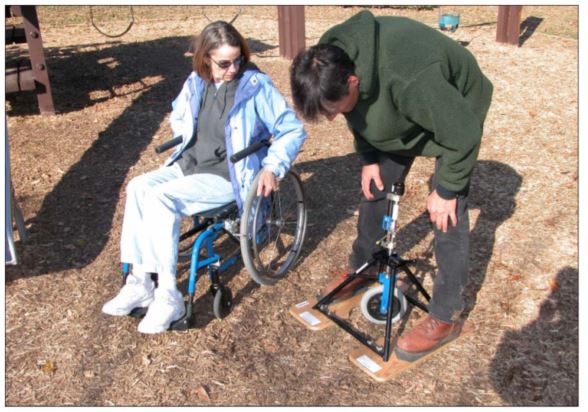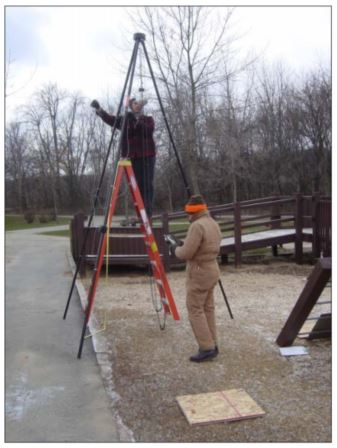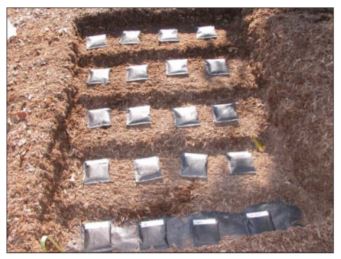Test Procedures
Field Observation Reports
The playground site was not under direct supervision or observation by park staff or other responsible personnel. However, on-duty staff noted any public concerns and changes at the site. Forest Products Laboratory staff visited the site at least weekly for the first 2 months and at least monthly thereafter (if the ground was thawed) to perform the rotational penetrometer test and to observe and annotate any maintenance needs, use patterns, or other issues.
Accessibility Measures
All surfaces were measured with the rotational penetrometer periodically over the first 6 months of exposure (Fig. 9). This device subjects the surface to a low-speed rotational bearing test that simulates the weight and action of a front caster wheel on a wheelchair. The procedures are based on a draft national standard test method for the firmness and stability of ground and floor surfaces (RESNA 2000), which uses an average of five readings. This test provides objective measures of surface firmness and stability and has been correlated to the work measurement of ASTM F1951, "Accessibility of Surface Systems," for a wide array of surfacing and floor coverings (ASTM 1999b). The RESNA test was performed 1 week after surface installation and as often as once a week in the first 2 months, using the rotational penetrometer and protocol for assessing bearing/ rotational surface indentation (Axelson and Chesney 1999). The device was used on test areas selected as representative of the entire surface.
Figure 9-Measurement of accessibility with rotational penetrometer.
Impact Attenuation Tests
Impact tests were performed by a cooperator (Zeager Bros. Inc.) 7 weeks after EWF installation. ASTM F1292-99 test methods were used at a constant test drop height of 3.05 m (10 ft) (Fig. 10). Maximum g levels and head injury criteria (HIC) were measured.
Figure 10-Impact test setup for drop height of 3.05 m (10 ft).
Moisture and Durability
To learn more about biodeterioration of the EWF playground system, we sampled and ovendried packets of EWF material and buried them in the unsurfaced portion of the playground. Polyolefin geotextile fiber pouches were each filled with approximately 40 oven-dry grams of fiber (Fig. 11). These biodeterioration samples were placed so as to allow circulation of water and air. The EWF surface was excavated throughout its entire 0.3-m (12-in.) depth to determine the moisture profile of the surfacing system. The samples were buried at depths of 100, 150, 200, 250, and 300 mm (4, 6, 8, 10 and 12 in.) (Fig. 11). One-quarter of the samples was removed at 6 months to provide data on wood fiber moisture content and weight loss. After drying and weighing, the removed packets were reinserted and the area was restored.
Figure 11-Biodeterioration samples on EWF surface.




User Comments/Questions
Add Comment/Question